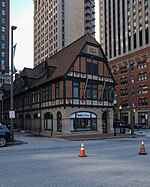Lombard Street (Baltimore)

Lombard Street is a major street in Baltimore. It forms a one-way pair of streets with Pratt Street that run west–east through downtown Baltimore. For most of their route, Pratt Street is one-way in an eastbound direction, and Lombard Street is one-way westbound. Both streets begin in west Baltimore at Frederick Avenue and end in Butcher's Hill at Patterson Park Avenue. Since 2005, these streets have been open to two-way traffic from Broadway until their end at Patterson Park; in addition, Lombard is also two-way from Fulton Avenue to Martin Luther King, Jr. Boulevard, near the University of Maryland at Baltimore campus.To the east of Patterson Park, both Pratt and Lombard Streets start again at Linwood Avenue. Lombard Street continues mostly as a multilane street until Kane Street, short of reaching Interstate 95. Lombard, which is known as Lombard Street East in this area, with part of an interchange with the Harbor Tunnel Thruway and access to Bayview Medical Center. Lombard Street is one of Downtown Baltimore's older streets. Its name comes from the Italian town Guardia Lombardi, as Lombard Street was originally an Italian settlement. It has undergone many changes over the past hundred years but became famous for its Corned Beef row.
Excerpt from the Wikipedia article Lombard Street (Baltimore) (License: CC BY-SA 3.0, Authors, Images).Lombard Street (Baltimore)
East Lombard Street, Baltimore Downtown
Geographical coordinates (GPS) Address Nearby Places Show on map
Geographical coordinates (GPS)
| Latitude | Longitude |
|---|---|
| N 39.287777777778 ° | E -76.613333333333 ° |
Address
East Lombard Street 108
21202 Baltimore, Downtown
Maryland, United States
Open on Google Maps










